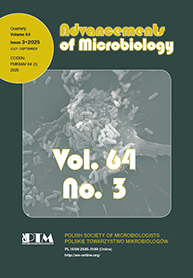Abstract: Akkermansia muciniphila is a gut bacterium that has recently attracted considerable attention in microbiota research. Its presence in the gut is associated with improved metabolic health, enhanced gut barrier integrity, and modulation of the immune system. However, potential risks related to its abundance under certain pathological conditions have also been noted. As A. muciniphila emerges as a candidate for next-generation probiotics, evaluating whether current data support its therapeutic use is crucial. In this review, we analyze the available literature to outline the beneficial effects of A. muciniphila on the host and critically assess its potential as a probiotic.
Browsing tag: Probiotics
Abstract: In recent years the field of probiotics, prebiotics, synbiotics and postbiotics has been extensively studied. Preparations including live and inanimate microorganisms, their parts and substances that selectively stimulate their growth, are promising in treatment or amelioration of symptoms in many diseases. The aftermath of the COVID-19 pandemic has forced us to face complications such as post-acute COVID-19 syndrome and a general decrease in population immunity, for which treatment with probiotics, prebiotics, synbiotics and postbiotics is promising. The use of such preparations can have a positive effect on the immune system and has also shown positive effects in major depressive disorder. Due to the rapid development in the field a lot of confusion and misconceptions emerged, especially regarding the use of terms and definitions. This article aims to present a clear classification of these products according to International Scientific Association of Probiotics and Prebiotics (ISAPP) guidelines as well as basic mechanisms of action and efficacy of selected preparations. Authors of this article use the term ‘biotic(s)’ to refer collectively to probiotics, prebiotics, synbiotics and postbiotics. While this term has not been officially established, it is used by other authors in the scientific literature. The taxonomic nomenclature used in this article has been updated according to the most recent taxonomic reclassification.
Abstract: Obesity is a disease which is currently one of the most serious problems affecting approximately 650 million people worldwide. Improper lifestyle is considered the primary cause of the disease; however, many other factors contribute to the problem. In recent years, attention has been drawn to the role of gut microbiota in developing and controlling obesity and overweight. Microorganisms in the gastrointestinal tract are responsible for the fermentation of certain nutrients, causing efficient digestion, stimulation of intestinal transit, vitamin production, and modulation of the host’s immune system. Numerous studies have demonstrated that gut microbiota composition differs between obese individuals and those with a normal body mass index (BMI). It has also been shown that altering gut microbiota can influence the phenotype of the host organism, promoting metabolic changes, including BMI reduction. Recent studies aimed at using probiotics to modify gut microbiota composition to reduce body weight are still inconclusive.
Abstract: A new class of feed additives and nutritional supplements, known as probiotics, include bacterial, fungal, and yeast cultures from various sources. Overall, probiotics are believed to promote the health and well-being of animals, birds, and humans in a variety of settings. Incorporating probiotics into the diets of cattle and poultry has been demonstrated to improve growth, feed conversion efficiency, immunological responses, and the animal’s ability to manage enteric infections. The use of probiotic-enriched chicken feed has been shown to enhance egg production by as much as 30% among laying chickens. Probiotics may be used to fight off harmful microorganisms, create antibacterial compounds (such as bacteriocins or colicins), and alter the immunological response of the host, according to the National Institutes of Health. Pathogenic microbial strains such as Lactobacillus, Streptococcus, Bacillus, Enterococcus, Pediococcus, Aspergillus, and Saccharomyces are employed in the making of chicken products. The use of subtherapeutic doses of antimicrobial agents, including antibiotics, to combat or remove harmful bacteria and promote animal growth and feed efficiency has resulted in the accumulation of antibiotic residues in animal feed as well as the emergence of drug-resistant microbes in the feed supply chain. As a result of public health concerns, there has been a renewed emphasis on the use of probiotics in chicken production rather than antibiotics in recent years. This research examines the effects of probiotics and direct-fed microorganisms (DFM) on chicken health and performance, with a particular emphasis on the favourable effects they have on poultry health and performance.
1. Introduction. 2. Probiotics’ historical development. 3. Criteria for a perfect probiotic. 4. Microbes commonly used as probiotics. 5. Probiotics in poultry applications. 6. Gastrointestinal tract probiotic colonization. 7. Continuing to improve digestion, nutrient metabolism and nutrient utilization. 8. Management of harmful pathogens and disease conditions. 9. Immunostimulation. 10. Probiotics as a growth institution. 10.1. Lactobacilli. 10.2. Aspergillus oryzae. 10.3. Yeast. 11. Salient benefits and recommendations for probiotic use. 12. Conclusion

